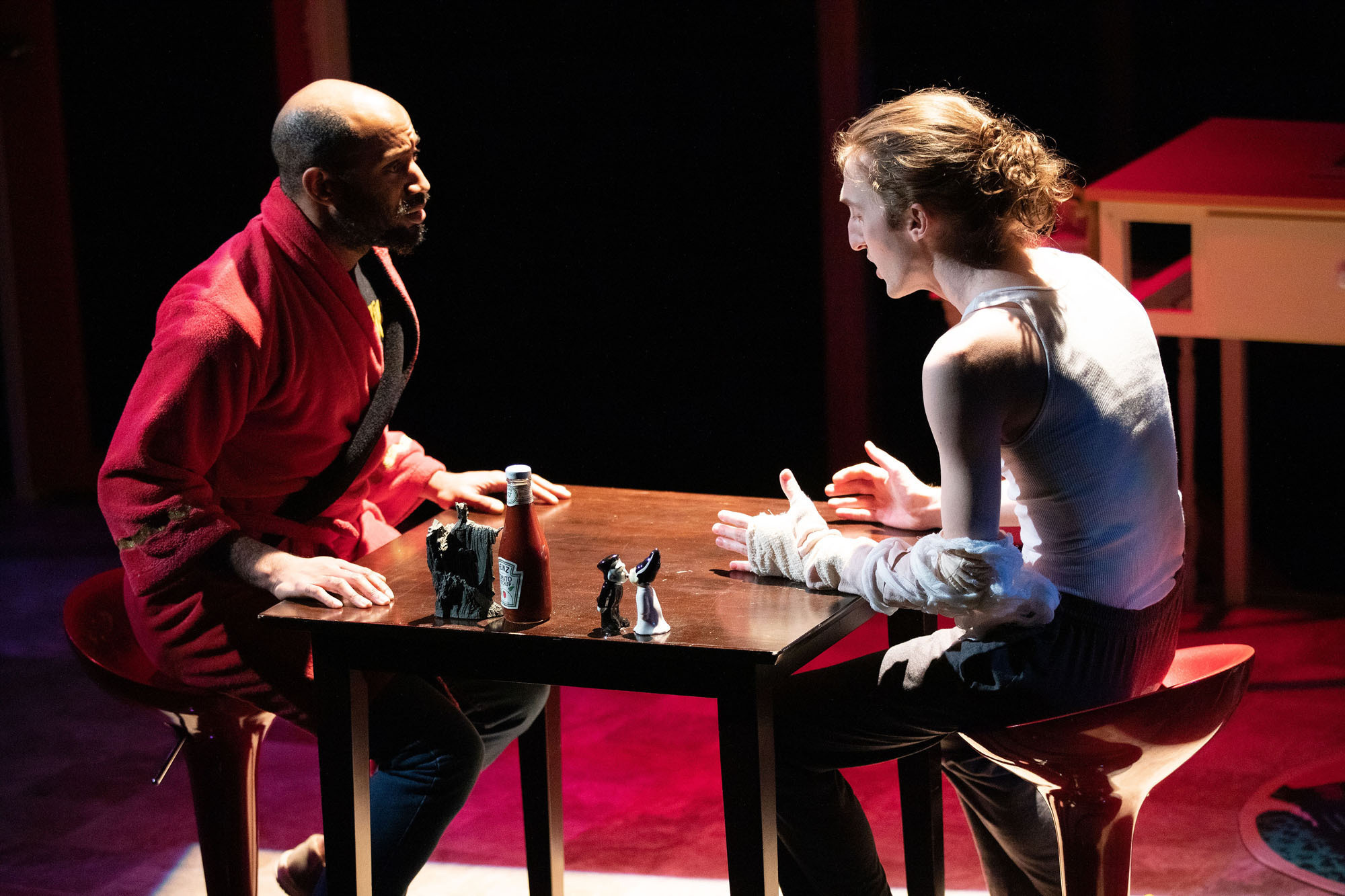The Monsters Under America’s Bed Have Come Out to Play
Review of Monsters of the American Cinema presented by ArtsWest
Written by Teen Writer Kyle Gerstel and edited by Teen Editor Valentine Wulf

In the two-person domestic drama Monsters of the American Cinema, ArtsWest invites audiences to confront the most difficult of demons: those in our own homes. Monsters follows the story of Remy Washington, a Black man who takes care of his dead husband’s straight, white teenage son, Pup. They bond through a shared love of classic monster movies, but tensions arise when Remy learns that Pup bullies a gay teen at his school, and frequently uses the n-word around his friends. Has Remy raised a monster? Meanwhile, Pup’s childhood nightmares of ghosts and monsters return with increased severity.
The 2021-2022 season When We Wake was curated by a cohort of ArtsWest leaders and Associate Artists over the course of eight months, focusing on themes of community, collective healing, and the power of storytelling. Unlike the first show of the season, We’ve Battled Monsters Before, which primarily explored cultural heritage through the lens of joy, Monsters of the American Cinema leaves audiences intentionally uncomfortable, contributing a more disturbing perspective to the discussion of identity prompted by the former.
However, this is not a Black trauma narrative: the show’s conflict is driven from the characters’ relationship rather than exploring social injustice on a global scale. Although there is a message, playwright Christian St. Croix effectively tells the story through a human lens.

Alexander Kilian (Pup) and Lamar Legend (Remy) bring energy to their roles without sacrificing the characters’ authenticity. Legend impressively serves as the production’s director as well, effortlessly navigating the text’s fluctuating tone and shifting himself and Kilian between the set and space around it.
The show focuses on the casual use of racist and homophobic language in the 21st century, a monster many choose to ignore until it leads to physical destruction. While the topic is important, the play often regurgitates what has been said in other pieces of media, rather than provoking audiences with fresh insights. In this regard, I much prefer Jeremy O. Harris’ controversial satire Slave Play, another recent show that explores the intersectionality of race and sexuality.
Despite this, St. Croix’s compelling dialogue allows the story to maintain simultaneous states of groundedness and progress. I was most engaged when Remy and Pup interacted with one another rather than speaking directly to the audience, as some of the monologues go on for too long without conflict. However, the mixture of styles strengthened the pacing.
Legend and St. Croix also choose to include nightmarish hallucination sequences involving moody lighting and distorted sound to address the darker aspects of Remy and Pup’s relationship. Some of the imagery makes it seem that the plot was primarily intended to serve as a metaphor rather than prioritizing the characters’ journeys. However, these scenes seamlessly heighten the tension, thus furthering audience members’ investment in the story.
The play ends with Pup evolving into a creature from his nightmares, attacking Remy and eventually hugging him. At first, the finale didn’t feel like a strong resolution for the characters’ bitter dynamic. However, in hindsight, it perfectly encapsulates the current moment—after doing our best to make progress, there is nothing we can do but embrace the things that are good.
Just as Remy and Pup bond through film, Monsters connects theatergoers, inspiring audiences to cultivate safe environments to facilitate and participate in uncomfortable conversations. In other words, the heart of the narrative parallels the show’s impact. St. Croix and the folks at ArtsWest have crafted a storytelling experience that is undeniably human, something we desperately need after being apart for so long.
Lead Photo: Alexander Kilian in Monsters of the American Cinema presented by ArtsWest. Photo by John McLellan.
The TeenTix Newsroom is a group of teen writers led by the Teen Editorial Staff. For each review, Newsroom writers work individually with a teen editor to polish their writing for publication. The Teen Editorial Staff is made up of 6 teens who curate the review portion of the TeenTix blog. More information about the Teen Editorial Staff can be found HERE.
The TeenTix Press Corps promotes critical thinking, communication, and information literacy through criticism and journalism practice for teens. For more information about the Press Corps program see HERE.

